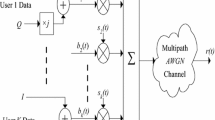Abstract
The performance of a conventional single user DS-CDMA receiver is severely limited by multiple access interference (MAI) and near–far effects. This severity has motivated research into adaptive filtering, near–far resistant detectors and power control strategies for DS-CDMA systems. In this paper, we propose a near–far resistant detector based on independent component analysis (ICA) of the received signal. Since ICA is a blind technique, the proposed ICA based detector has the potential to combat the near–far problem. The ICA is a higher order statistical technique based on the assumption of independence of source signals. The assumptions in ICA algorithm are the realistic conditions in a DS-CDMA system and therefore ICA algorithm can be applied successfully to detect the signal of the desired user. The focus of this paper is to illustrate the near–far resistance capability of the ICA based detector. Simulation studies performed on the proposed detector show that it is resistant to the near-far problem and has low bit error rate.
Similar content being viewed by others
References
W.Y. Leong and J. Homer, “Blind Multiuser Receiver in Rayleigh Fading Channel”, Proceeding of the IEEE AusCTW, Brisbane, Australia, pp. 155–161, 2005.
J. Saxena, C.S. Rai and P.K. Bansal, “Detection of DS-CDMA Signals based on Independent Component Analysis”, Proceedings of the IEEE International Symposium on Signal Processing and its Applications, ISSPA, Australia, pp. 367–370, 2005.
Moshavi S., (1996). “Multiuser Detection for DS-CDMA Communications”. IEEE Communication Magazine 34(10): 124–137
S. Verdu, “Minimum Probability of Error for Asynchronous Gaussian Multiple Access Channels”, IEEE Transactions Information Theory, Vol IT-32, pp. 85–96, 1986.
Lupas R., Verdu S., (1989). “Linear Multi user Detectors for Synchronous CDMA Channels”. IEEE Transactions on Information Theory 35, 123–136
Madhow U., (1994). “MMSE Interference Suppression for Direct Sequence Spread Spectrum CDMA”. IEEE Transactions on Communication 42(12): 3178–3188
Patel P., Holtzman J., (1994). “Analysis of a Simple Successive Interference Cancellation Scheme in DS-CDMA System”. IEEE Journal in Selected Areas in Communication 12(5): 796–807
Duel-Hallen A., (1995). “A Family of Multi user Decision Feedback Detectors for Asynchronous CDMA Channels”. IEEE Transactions on Communications 43, 421–434
Madhow U., (1998). “Blind Adaptive Interference Suppression for DS-CDMA”. Proceedings of the IEEE 86(10): 2049–2069
Bell A.J., Sejnowski T.J., (1995). “An Information-maximization Approach to Blind Separation and Blind Deconvolution”. Neural Computation 7: 1129–1159
S. Amari, S.C. Douglas, A. Cichocki and H.H. Yang, “Multichannel Blind Deconvolution and Equalization Using the Natural Gradient”, Proc IEEE Workshop on Signal Processing Advances in Wireless Communication (SPAWC), Paris, France, pp. 101–104, 1997.
Honig M., Madhowv, Verdu S., (1995). “Blind Adaptive Multi User Detection”. IEEE Transaction on Information Theory 41, 944–960
Wang X., Poor H.V., (1998). “Blind Equalization and Multi User Detection in Dispersive CDMA Channels”. IEEE Transactions on Communications 46(1): 91–103
Yang T.T., Mikhael W.B., (2006). “Practical Technique for Joint Image Rejection and Carrier Frequency Offset Compensation for Diversity Wireless Receivers”. Electronics Letters 42(5): 310–311
Kostanic I., Mikhael W., “ICA Based Non-Coherent QAM Receiver Architecture”. Proc. IEEE Int. Conf. Neural Networks and Signal Processing, Nanjing, China, pp. 1350–1353, 2003.
Yang T., Mikhael W.B., (2004). “Practical Image Rejection for Single Branch BPSK Receivers”. Electronics Letters 40(22): 1–2
Comon P., (1994). “Independent Component Analysis, A New Concept?”. Signal Processing 36(3): 287–314
Amari S.I., Cichoki A., Yang H., “ A New Learning Algorithm for blind signal separation”. Advances in Neural Information Processing Systems, 8, 757–763, Denver, 1996.
Hyvarinen A., Oja E., Karhunen J., (2001). Independent Component Analysis. New york, Wiley Inc
Cardoso J.F., Laheld B.H., (1996). “Equivariant Adaptive Source Separation”. IEEE Transactions on Signal Processing 44(12): 3017–3030
Lee T.-W., Girolami M., Sejnowski T.J., (1999). “Independent Component Analysis using an Extended Infomax Algorithm for Mixed Sub-Gaussian and Super-Gaussian Sources”. Neural Computation 11(2): 417–441
Karhunen J., Oja E., wang L., Vigario R., Joutsensalo J., (1997). “ A Class of Neural Networks for ICA”. IEEE Transactions Neural Networks 8(3): 486–504
F. Carlier and F. Nouvel, “Unsupervised Neural Networks for Multiuser Detection in MC-CDMA Systems”, Proceedings of the IEEE ICPWC, New Delhi, India, pp. 255–259, 2002.
Charoensak C., Sattar F., (2005). “A Single-Chip FPGA Design for Real-Time ICA-Based Blind Source Separation Algorithm”. Proceedings of the IEEE 6: 5822–5825
Author information
Authors and Affiliations
Corresponding author
Rights and permissions
About this article
Cite this article
Saxena, J., Rai, C.S. & Bansal, P.K. Near–Far Resistant ICA based Detector for DS-CDMA Systems in the Downlink. Wireless Pers Commun 43, 341–353 (2007). https://doi.org/10.1007/s11277-006-9227-2
Received:
Accepted:
Published:
Issue Date:
DOI: https://doi.org/10.1007/s11277-006-9227-2




